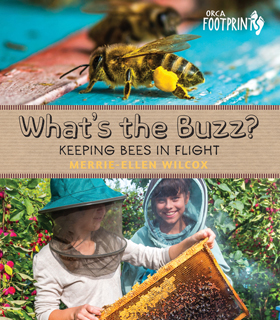| ________________
CM . . .
. Volume XXII Number 1. . . .September 4, 2015

 |
What’s the Buzz? Keeping Bees in Flight. (Orca Footprints).
Merrie-Ellen Wilcox.
Victoria, BC: Orca, 2015.
48 pp., hardcover, pdf & epub, $19.95 (hc.).
ISBN 978-1-4598-0960-4 (hc.), ISBN 978-1-4598-0961-1 (pdf), ISBN 978-1-4598-0962-8 (epub).
Subject Heading:
Bees-Juvenile literature.
Grades 5-7 / Ages 10-12.
Review by Daphne Hamilton-Nagorsen.
***˝ /4
|
| |
|

excerpt:
Of all the bees on the planet, honey bees have always been the most loved by humans. The first known record of people harvesting honey from wild bees is a 6,000-year-old cave painting in Spain. Both the ancient Egyptians and the Chinese kept bees in hives 4,000 years ago. The ancient Greeks believed honey to be the food of the gods. The first alcoholic drink, made from fermented honey and known as mead, was used in Africa, China and Europe thousands of years ago. Bees and honey also had important roles in the Mayan and Aztec civilizations.
Our love for bees even shapes our languages. For example, in the Slovenian language there are two words for death: one is used only for humans and bees, and the other is used for all other creatures. And in English we have lots of expressions that refer to bees, such as “He’s as busy as a bee,” “She’s got a bee in her bonnet,” and “I think you’re the bee’s knees.”
What’s the Buzz? is a look at bees and bee-keeping. Presented with many photographs and lots of interesting information, What’s the Buzz? gives a strong, if brief, overview of bees and their relationship with humans, especially the impact that humans are having on bee populations.
What’s the Buzz? is broken into four chapters, each covering a different topic. Chapter 1 covers the basics of bee biology and bee life. Chapter 2 focuses on the role bees play in pollination and the challenges bees are facing from human activity. Chapter 3 moves on to the specifics of life in a bee colony and the basics of what bee keepers do. Chapter 4 returns to the challenges that bees face from humans and what can be done to help bees.
The content is presented simply, with many photographs to help illustrate the material and interest readers. There are also “bee facts” alongside the text, adding interesting information, such what cuckoo bees are. Additionally, short sections called “All Abuzz” present anecdotes and information from the author’s foray into bee-keeping. This gives the information a personal aspect which helps interest the reader in the material.
The interest that Merrie-Ellen Wilcox has in bees and her concern about their future comes through in all aspects of the text. The material only provides an overview of bees and the challenges they face, but the author’s enthusiasm for the topic is apparent and will help readers become more interested in bees and their future.
The table of contents is extremely well laid out, listing not only the chapters, but the sections of the chapters, making the information very easy to access. The resources page lists a number of relevant resources. While only two books are listed, there are a substantial number of good quality websites that are age-appropriate. Most of the resources are about the perils facing bees and how to help save bees. This is a major focus of What’s the Buzz?; however, some more resources about bees in general would also be useful.
The glossary is well-designed, with glossary terms appearing in italics throughout the text. The glossary contains a substantial number of terms and defines these terms well and in an age-appropriate fashion.
What’s the Buzz? is a well-written overview of bees which shows how important they are as well as the perils that bees face and what people can do to help bee populations survive.
Highly Recommended.
Daphne Hamilton-Nagorsen is a graduate of the School of Library, Archival and Information Studies at the University of British Columbia, Vancouver, BC.

To comment
on this title or this review, send mail to cm@umanitoba.ca.
Copyright © the Manitoba Library Association. Reproduction for personal
use is permitted only if this copyright notice is maintained. Any
other reproduction is prohibited without permission.
Next Review | Table of Contents For This Issue - September 4, 2015
CM Home | Back Issues
| Search
| CM Archive
| Profiles Archive
|
